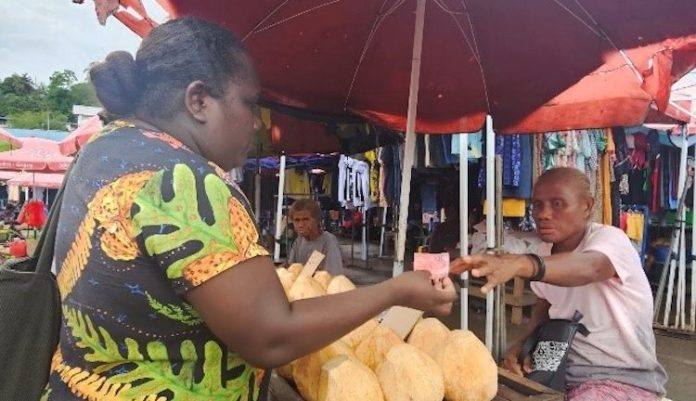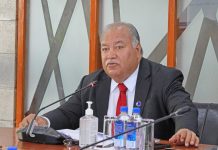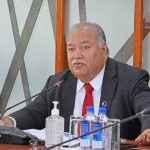
By Stephen Diisango*
The hostile, coconut rhinoceros beetle (CRB) is threatening Solomon Islands coconut plantations likely subjecting to extinction. It poses a serious threat to the country’s coconut industry unless urgent steps are taken to exterminate this coconut pest once and for all.
Known regionally as the ‘tree of life’, every part of the coconut tree is used – from its tallest frond down to its rooted trunk—from the sweet, delectable juice and fresh meat of its fruits, to its husks to that fuel fires, the fronds that make baskets, and the trunks that go into building homes and furniture.
It is of great worry that this destructive pest is doing damage to coconut trees that have for years provided the nation with much-needed foreign currency.
Coconuts are one of the most important cash crops in Solomon Islands, that produce more than 300 million coconuts per year—some estimates even put the figure at nearly 500 million nuts. Copra exports are valued at SBD 300–400 million (USD 35-46 million) a year, according to the commodities dealer ‘Solomon Commodities’.
Deputy Director of Biosecurity Solomon Islands (BSI), Crispus Fanai, confirmed that based on DNA analysis the beetle originated from the US-administered Guam island in the South Pacific, and has moved from Guam to Papua New Guinea and then to Solomon Islands.
With the intensifying threat currently caused by this destructive beetle, it will surely make a cut in the country’s economy regarding copra exports.
Concerned about the threat to Solomon Islands economy, Fanai explained to Wansolwara, some of the measures BSI is taking to protect the plantations.
It includes measures such as early detection to eradicate the beetle “It is important for prompt action to prevent the problem from intensifying” says Fanai., “Pheromone traps are mounted to capture adult beetles”. He also added that clean-up campaigns have been mounted where biosecurity officers visit infected areas and destroyed breeding sites. They also cut down dead coconut trees for burning,
Hygiene and sanitation are also important factors he points out, where the fallen and rotting coconut branches and fruits are cleared from plantations to help reduce beetle infestations. The green muscardine fungus (GMF)t—he biological agent – is used to kill the CRB-Guam (CRB-G) to reduce the beetle population. Quarantine measures have also gone into operation, where biosecurity officers monitoring main ports to restrict the movement of infested plant materials.
The coconut beetle was first discovered in Honiara, in January 2015.
Fanai said that “the beetle is a serious threat not only to Solomon Islands’ coconut industry but to all Pacific island countries’ coconut industries”, adding that “research into biocontrol organisms is ongoing while Solomon Islands approach to biocontrol usage is still not in full force”.
He said the beetle is one of the world’s most destructive agricultural pests and also becomes a threat to other palm species like oil palm, sago and royal palms, and betel nuts.
Local women selling coconut products at the Honiara Central Market described the beetle as a “disaster.”
“This beetle is a disaster. The low supply of coconut fruits from our main suppliers is a direct impact on coconut yields. This is indeed affecting us, especially women, who depend entirely on coconut products for livelihood”, a group of women vendors told Wansolwara
“We used to sell about 300 and 700 nuts a day when there was no beetle. Today, the highest we can sell is between 50 and 200 fruits. Indeed, a huge drop in our daily earnings. The impact of this beetle on the coconut industry is serious and is affecting our livelihood, especially women who struggle every day to put food on the table,” they added.
Rolland Adovi from Guadalcanal Province, who is involved in copra production told Wansolwara, CRB is a grave threat “not only to the coconut industry but also to the economy, given that coconut is one of the main commodities that contributed significantly to the country’s economy for years”.
He said that the beetle damage trees and affected yields, resulting in a substantial drop in his copra production.
Despite the impacts, Adovi said he continues to observe biosecurity advice and control measures.
He said that since the beetle is here to stay, the government, through its Biosecurity Department, needs to step up in its effort to manage it and he further suggested that the government should also provide subsidies to affected farmers for replanting initiatives.
Meanwhile, Fanai emphasised that while it takes the government through BSI to implement measures to control the pest, its success depends entirely on everyone’s cooperation to reduce this beetle population.
He said such an undertaking requires collective effort between the government, private sector, donor partners, communities and coconut farmers.
Before the beetle arrived in Solomon Islands, it had arrived in Hawaii and Guam, despite the significant efforts of the Department of Agriculture of the United States.
Guam now expects to lose 50-70 percent of its coconuts, and its government has spent about USD 2.5 million in eradication programs but to no avail, according to research.
With this great impact that the beetle can have on the copra industry and the country’s economy, it, therefore, needs urgent action from the responsible authorities to manage it before the government chucks in millions of dollars as Guam did in its program effort to eradicate the pest.
In Honiara, there are coconut trees dying due to the destructive beetle. However, Fanai assured citizens that the fight against the beetle is not yet over.
Native to Southeast Asia, CRB is a large scarab beetle. Today, it has spread throughout the Pacific
If the beetle continues to spread, it is estimated the Pacific could lose up to USD$145 million per year by 2040 from damage to coconut trees alone.
Thus, a concerted effort to manage the beetle has been initiated under the regional ‘Pacific Awareness and Response to Coconut Rhinoceros Beetles (PARC)’ project to help strengthen the Pacific’s capacity to detect and control the spread of CRB.
The project is coordinated by the Pacific Community (SPC) under the auspices of the Pacific Plant Protection Organisation and funded by the New Zealand government through its Ministry of Foreign Affairs and Trade.
The four-year PARC project will operate mainly in Vanuatu, Solomon Islands and PNG. It seeks to empower and strengthen regional capacity to control the spread and suppress the population of CRB, by enhancing Pacific ability to prepare for and respond to CRB pest incursion by building a regional CRB-G research and development management system
* Stephen Diisango is a journalism student at the University of the South Pacific in Fiji. This story is being transmitted by IDN-In Depth News under arrangements with the University of the South Pacific students’ newspaper Wansolwara.














